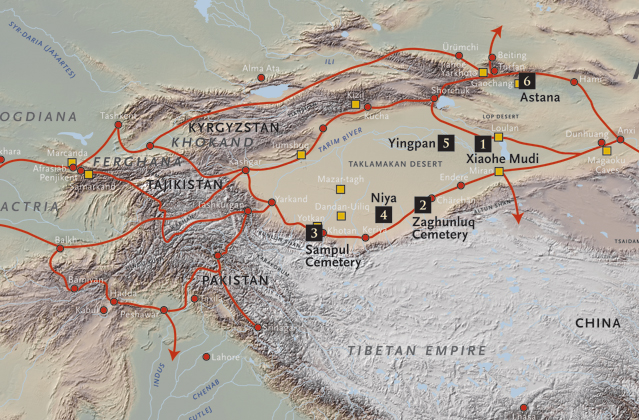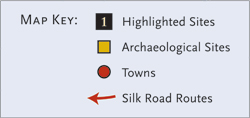Exhibit - The Western Regions
Where is the Tarim Basin?
The area now known as Xinjiang was a late addition to the Chinese Empire, only becoming a province of China in 1884. Before that, beginning approximately in the 2nd century CE, this area in Central Asia was known as the Western Regions. Surrounded by mountains on all sides, this extremely arid expanse of land is home to the second largest desert in the world, the Taklamakan. Small river oases are scattered throughout the region.
The Tarim Basin is located south of the Tian Shan Mountians in the Western Regions. Many different peoples lived and passed through the Tarim Basin, before the Silk Road and after its height. The lifestyles of the people living in the Tarim Basin varied over time and across the region. The people of the northern steppe land, for example, were primarily nomadic herders, while others lived as farmers.
Because of its central location and the many oasis towns in an otherwise harsh landscape, the Tarim Basin became a passageway for those traveling between east and west. As many of the artifacts and sites confirm, the area has been active from prehistory to the present, not only during the height of the Silk Road.


1. Xiaohe Mudi (she-ow-HUH MOO-dee),
also called Small River Cemetery Number 5
2000–1450 BCE
Most Important Find on Display: The Beauty of Xiaohe
Other Finds: Excavations at the site yielded more than
1,000 artifacts from 167 graves, including more than 30 well-preserved mummies.
You Should Know: There is no evidence of any settlements within several kilometers of the cemetery, raising questions about the identities and lives of the people buried there.
2. Zaghunluq Cemetery (zah-gun-LUK)
Active Dates: 1000–600 BCE
Most Important Find on Display: Infant Mummy
Other Finds: During excavation, the foreleg of a horse was found stuffed with reeds in place of the bone, a practice
similar to that of ancient Indo-Europeans.
You Should Know: Located in the town of Chärchän
(cher-chen), Zaghunluq Cemetery boasts some of the
best preserved organic remains, due in part to the high
saline content of the soil.
3. Sampul Cemetery (sahm-POOL)
Active Dates: 200 BCE–200 CE
Most Important Find on Display: Wall Hanging with
Warrior and Centaur Design
Other Finds: Two astonishing shaft graves were discovered
with the combined burials of 279 people, along with
timber-built graves and boat-shaped coffins.
You Should Know: Located east of the garrison town
of Khotan, Sampul is part of a huge series of cemeteries
spanning 8 square miles.
4. Niya (NEE-ah)
Active Dates: 1–500 CE
Most Important Find on Display: Wooden Buddhist Sculpture
Other Finds: The bronze mirrors, silks, and embroidery found
there provide evidence that the people of Niya traded extensively with the Chinese.
You Should Know: The northern section of Niya boasts
hundreds of well-built houses, plus the facilities for working
iron and bronze, and a Buddhist stupa, a religious structure
that contains relics.
5. Yingpan (ING-pan)
Active Dates: 300 BCE–500 CE
Most Important Find on Display: The Trappings of Yingpan Man
Other Finds: Yingpan has yielded some of the most splendid
and extravagant textiles found in the Tarim Basin.
You Should Know: The circular layout of Yingpan featured
a Buddhist temple, a soaring beacon tower, and a large
public cemetery.
6. Astana (AH-stah-nah) Cemetery
Active Dates: 300–700 CE
Most Important Find on Display: Many items found at Astana are on display; some of the most remarkable are the wooden
and clay figurines depicting daily life, as well as the food items.
Other Finds: Over 3,000 Chinese documents, including
account books, contracts, and official records were found
at Astana. They chronicle the economic, military, and cultural
history of the region’s medieval period.
You Should Know: The people buried at Astana were nearly
all East Asian, showing a dramatic shift in ethnicity in the
Tarim Basin.















